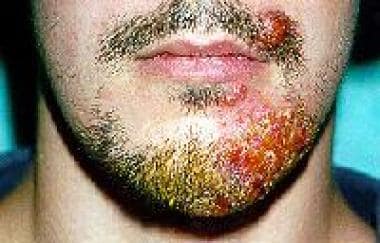Tinea barbae is a dermatophyte infection affecting the bearded regions of the face and neck. Predominantly seen in adult men, it is caused by a group of fungi known as dermatophytes, particularly species of Trichophyton and Microsporum. This condition often results from contact with infected animals or contaminated tools and surfaces.
It presents in two primary clinical forms: a superficial form resembling tinea corporis and a deep inflammatory type, often known as kerion, which mimics bacterial folliculitis but requires entirely different management.

Causes and Risk Factors of Tinea Barbae
Primary Causes:
- Zoophilic dermatophytes: Trichophyton verrucosum (from cattle) and Trichophyton mentagrophytes (from rodents and pets)
- Anthropophilic species: Rarely involved, but Trichophyton rubrum can cause infection through contaminated grooming tools
Risk Factors:
- Occupational exposure to livestock (farmers, veterinarians)
- Use of contaminated razors or barber equipment
- Poor hygiene and shared grooming tools
- Compromised immunity
- Warm, humid environments
Clinical Presentation and Tinea Barbae Symptoms
Tinea barbae typically presents as red, scaly plaques in the beard area. The condition can be superficial or deep depending on the fungal species and host immune response.
Superficial Tinea Barbae:
- Scaly, red patches resembling eczema or psoriasis
- Mild itching and irritation
- Hair shafts may become brittle and break easily
Inflammatory (Deep) Tinea Barbae:
- Swollen, tender nodules and abscess-like lesions
- Pus formation and crusting
- Loosening or permanent loss of beard hair
- Systemic symptoms such as fever and lymphadenopathy in severe cases
Diagnosis of Tinea Barbae: Methods and Differentiation
Correct diagnosis is crucial as deep tinea barbae can mimic bacterial infections like folliculitis or abscesses, often leading to mismanagement.
Diagnostic Tools:
- Wood’s Lamp: May fluoresce depending on fungal species
- Direct Microscopy (KOH prep): Reveals fungal hyphae in hair shafts and skin scrapings
- Fungal Culture: Identifies specific dermatophyte species
- Skin Biopsy: Reserved for deep or atypical presentations
Differential Diagnoses:
- Bacterial folliculitis
- Acne keloidalis nuchae
- Pseudofolliculitis barbae
- Lupus erythematosus
- Sycosis barbae (bacterial infection)
Tinea Barbae Treatment: Best Practices and Antifungal Therapies
Prompt antifungal therapy is essential to prevent complications such as scarring or secondary bacterial infections.
First-Line Treatment:
- Systemic Antifungals: Necessary due to deep follicular involvement
- Terbinafine: 250 mg/day for 4–6 weeks
- Itraconazole: 100–200 mg/day for 4–6 weeks
- Griseofulvin: 500–1000 mg/day for 6–8 weeks (older but still effective)
Topical Antifungals:
- Adjunctive therapy for mild superficial lesions
- Clotrimazole, Ketoconazole, Terbinafine creams
Additional Measures:
- Antibacterial agents if secondary infection is suspected
- Warm compresses for draining kerions
- Avoid shaving until infection resolves
Prevention of Beard Ringworm: Hygiene and Behavioral Recommendations
Preventing recurrence and transmission involves both personal and environmental hygiene.
Personal Hygiene:
- Avoid sharing razors, towels, or grooming tools
- Shave with clean, disinfected blades
- Maintain dry and clean beard area
- Seek prompt care for pets with visible skin issues
Environmental Control:
- Regular disinfection of barber instruments
- Veterinary screening for livestock and pets
- Education in high-risk professions (e.g., farming, barbershops)
Complications and Prognosis
Without timely treatment, tinea barbae may lead to:
- Permanent hair loss due to follicle destruction
- Deep scarring and keloid formation
- Chronic or recurrent infections
- Secondary bacterial infections requiring antibiotic therapy
With early diagnosis and systemic treatment, prognosis is excellent. Most patients recover fully without residual scarring.
Summary: Key Takeaways on Tinea Barbae
Tinea barbae is a fungal infection requiring clinical awareness and systemic antifungal therapy for successful resolution. Early diagnosis and appropriate management can prevent complications and transmission. Individuals in high-risk environments should adopt preventive hygiene practices to mitigate exposure.
Frequently Asked Questions:
What causes tinea barbae?
Tinea barbae is caused by dermatophyte fungi, primarily Trichophyton verrucosum and Trichophyton mentagrophytes, often contracted from animals or contaminated tools.
Is tinea barbae contagious?
Yes, it can spread through direct contact with infected individuals, animals, or contaminated surfaces like razors and towels.
How is tinea barbae diagnosed?
Diagnosis involves skin scraping with KOH examination, fungal culture, and in some cases, biopsy for deeper infections.
Can tinea barbae be treated with over-the-counter creams?
Topical creams may help in mild superficial cases, but deep infections usually require oral antifungal medications for complete clearance.
How long does it take to cure tinea barbae?
Treatment typically lasts 4–8 weeks depending on the severity and the antifungal used. Early treatment results in faster resolution and less scarring.